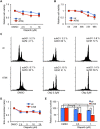ATM-depletion in breast cancer cells confers sensitivity to PARP inhibition
- PMID: 24252502
- PMCID: PMC4176289
- DOI: 10.1186/1756-9966-32-95
ATM-depletion in breast cancer cells confers sensitivity to PARP inhibition
Abstract
Background: Mutations in the DNA damage response (DDR) factors, breast cancer 1 (BRCA1) and BRCA2, sensitize tumor cells to poly(ADP-ribose) polymerase (PARP) inhibitors. The ataxia telangiectasia mutated (ATM) kinase is a key DDR protein whose heterozygous germline mutation is a moderate-risk factor for developing breast cancer. In this study, we examined whether ATM inactivation in breast cancer cell lines confers sensitivity to PARP inhibitors.
Methods: Wild-type BRCA1/2 breast cancer cells (i.e., MCF-7 and ZR-75-1 lines) were genetically manipulated to downregulate ATM expression then assayed for cytostaticity/cytotoxicity upon treatment with PARP inhibitors, olaparib and iniparib.
Results: When ATM-depleted cells and their relative controls were treated with olaparib (a competitive PARP-1/2 inhibitor) and iniparib (a molecule originally described as a covalent PARP-1 inhibitor) a different response to the two compounds was observed. ATM-depletion sensitized both MCF-7 and ZR-75-1 cells to olaparib-treatment, as assessed by short and long survival assays and cell cycle profiles. In contrast, iniparib induced only a mild, ATM-dependent cytostatic effect in MCF-7 cells whereas ZR-75-1 cells were sensitive to this drug, independently of ATM inactivation. These latest results might be explained by recent observations indicating that iniparib acts with mechanisms other than PARP inhibition.
Conclusions: These data indicate that ATM-depletion can sensitize breast cancer cells to PARP inhibition, suggesting a potential in the treatment of breast cancers low in ATM protein expression/activity, such as those arising in mutant ATM heterozygous carriers.
Figures




Similar articles
-
53BP1 depletion causes PARP inhibitor resistance in ATM-deficient breast cancer cells.BMC Cancer. 2016 Sep 9;16(1):725. doi: 10.1186/s12885-016-2754-7. BMC Cancer. 2016. PMID: 27613518 Free PMC article.
-
Low ATM protein expression and depletion of p53 correlates with olaparib sensitivity in gastric cancer cell lines.Cell Cycle. 2014;13(13):2129-37. doi: 10.4161/cc.29212. Epub 2014 May 19. Cell Cycle. 2014. PMID: 24841718 Free PMC article.
-
Combined PARP and ATR inhibition potentiates genome instability and cell death in ATM-deficient cancer cells.Oncogene. 2020 Jun;39(25):4869-4883. doi: 10.1038/s41388-020-1328-y. Epub 2020 May 23. Oncogene. 2020. PMID: 32444694 Free PMC article.
-
[From poly(ADP-ribose) discovery to PARP inhibitors in cancer therapy].Bull Cancer. 2015 Oct;102(10):863-73. doi: 10.1016/j.bulcan.2015.07.012. Epub 2015 Sep 15. Bull Cancer. 2015. PMID: 26384693 Review. French.
-
Poly(ADP-ribose) polymerase inhibition: a new direction for BRCA and triple-negative breast cancer?Breast Cancer Res. 2011 Aug 16;13(4):218. doi: 10.1186/bcr2877. Breast Cancer Res. 2011. PMID: 21884642 Free PMC article. Review.
Cited by
-
Perspectives on PARP inhibitors as pharmacotherapeutic strategies for breast cancer.Expert Opin Pharmacother. 2021 Jun;22(8):981-1003. doi: 10.1080/14656566.2021.1876662. Epub 2021 Jun 7. Expert Opin Pharmacother. 2021. PMID: 33646064 Free PMC article. Review.
-
Low ATM protein expression in malignant tumor as well as cancer-associated stroma are independent prognostic factors in a retrospective study of early-stage hormone-negative breast cancer.Breast Cancer Res. 2015 May 3;17(1):65. doi: 10.1186/s13058-015-0575-2. Breast Cancer Res. 2015. PMID: 25935535 Free PMC article.
-
Mutations of human DNA topoisomerase I at poly(ADP-ribose) binding sites: modulation of camptothecin activity by ADP-ribose polymers.J Exp Clin Cancer Res. 2014 Sep 17;33(1):71. doi: 10.1186/s13046-014-0071-z. J Exp Clin Cancer Res. 2014. PMID: 25227992 Free PMC article.
-
In Silico Screening Identifies a Novel Potential PARP1 Inhibitor Targeting Synthetic Lethality in Cancer Treatment.Int J Mol Sci. 2016 Feb 19;17(2):258. doi: 10.3390/ijms17020258. Int J Mol Sci. 2016. PMID: 26907257 Free PMC article.
-
Synthetic Lethality of PARP Inhibition and Ionizing Radiation is p53-dependent.Mol Cancer Res. 2018 Jul;16(7):1092-1102. doi: 10.1158/1541-7786.MCR-18-0106. Epub 2018 Mar 28. Mol Cancer Res. 2018. PMID: 29592899 Free PMC article.
References
-
- Farmer H, McCabe N, Lord CJ, Tutt AN, Johnson DA, Richardson TB, Santarosa M, Dillon KJ, Hickson I, Knights C, Martin NM, Jackson SP, Smith GC, Ashworth A. Targeting the DNA repair defect in BRCA mutant cells as a therapeutic strategy. Nature. 2005;434(7035):917–921. doi: 10.1038/nature03445. - DOI - PubMed
Publication types
MeSH terms
Substances
LinkOut - more resources
Full Text Sources
Other Literature Sources
Medical
Research Materials
Miscellaneous

